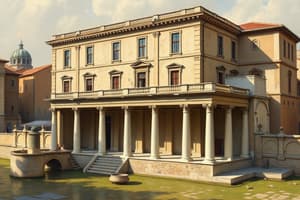Podcast
Questions and Answers
What was the primary purpose of the Cloaca Maxima in Ancient Rome?
What was the primary purpose of the Cloaca Maxima in Ancient Rome?
- To supply drinking water
- To transport goods
- To drain local marshes and remove waste (correct)
- To provide recreational areas
Which Roman emperor is associated with the construction of the Aqua Claudia?
Which Roman emperor is associated with the construction of the Aqua Claudia?
- Claudius (correct)
- Trajan
- Hadrian
- Caracalla
What was Pozzolana primarily used for in ancient Roman construction?
What was Pozzolana primarily used for in ancient Roman construction?
- Hydraulic cement (correct)
- Road paving
- Structural support
- Water filtration
What significant feature of Roman arches helps distribute weight?
What significant feature of Roman arches helps distribute weight?
Who built the Domus Aurea after the great fire of 64 AD?
Who built the Domus Aurea after the great fire of 64 AD?
What was the main purpose of the Colosseum in Ancient Rome?
What was the main purpose of the Colosseum in Ancient Rome?
Which forum is associated with the governance of Ancient Rome and was built under Vespasian?
Which forum is associated with the governance of Ancient Rome and was built under Vespasian?
What is the Vallum Wall associated with in Roman history?
What is the Vallum Wall associated with in Roman history?
Flashcards
Roman Aqueducts
Roman Aqueducts
Water supply systems using channels and structures to convey water over long distances. Examples include Aqua Claudia & Anio Novus.
Roman Arches
Roman Arches
Buildings using arches for support, distributing weight well and allowing for open spaces. Keystone supports.
Cloaca Maxima
Cloaca Maxima
Ancient Rome's earliest sewage system, draining marshes and carrying waste to the Tiber River.
Roman Forum
Roman Forum
Signup and view all the flashcards
Roman Roads (Appian Way)
Roman Roads (Appian Way)
Signup and view all the flashcards
Vallum Wall (Hadrian's Wall)
Vallum Wall (Hadrian's Wall)
Signup and view all the flashcards
Pozzolana
Pozzolana
Signup and view all the flashcards
Domus Aurea
Domus Aurea
Signup and view all the flashcards
Study Notes
Roman Architecture Summary
- Roman architecture featured a model of Rome, showcasing the layout of the city.
- The Roman Empire encompassed a vast geographical area, including locations like Gaul, Spain, Italy, and Africa. Major cities within this domain included Rome, Aquileia, Marseilles, Cordoba, Carthage, Alexandria, and Jerusalem.
- Roman innovation in construction was largely owed to their development of slow-drying concrete (using pozzolana sand). This allowed for construction of bases, walls, and other structures primarily or in conjunction with concrete and rubble. Facings were built with more expensive stones or inexpensive brick for a strong, customizable result.
Roman Wall Building Materials and Techniques
- Roman wall construction used various materials that were strategically combined. These combinations included concrete fill, bricks, and veneers.
- Different styles of masonry construction were used in Roman walls, such as opus incertum, opus reticulatum, and opus testaceum.
Roman Sewer Systems
- The Cloaca Maxima was one of the world's early sewage systems, built in ancient Rome.
- Its purpose was to drain local marshes and carry away waste from the populous city, flowing into the Tiber River.
Roman Roads
- Roman roads, exemplified by the Via Appia, were characterized by strong foundations and multiple layers of materials, including paving stones, broken stone, pebbles, cement, and sand.
- Road construction included kerb stones at the sides to create channels for draining water.
- The distance along roadways was marked with milliaria (stones).
Components of Road Construction
- The process of constructing a Roman road began with a trench.
- Boulders followed to form a base, and then layers of sand and gravel.
- Finally, paving stones were laid.
Roman Empire Road Network
- The Roman road network stretched across the empire, linking major settlements. A map of the Viae (roads) of Rome reveals these extensive routes.
Roman Emperors and Their Reigns
- Augustus (63 BC-AD 14)
- Claudius (AD 41 to 54)
- Nero (AD 54 to 68)
- Vespasian (69 AD to 79 AD)
- Titus (79 AD to 81 AD)
- Hadrian (117 AD to 138 AD)
- Trajan (98 AD to 114 AD)
- Caracalla (211 AD to 217 AD)
Pozzolana Summary
- Pozzolana, also spelled pozzuolana or pozzolan, is a form of hydraulic cement.
- It was/is discovered by the Romans and is still used in some countries.
- Pozzolana is a type of slag, either natural (volcanic) or artificial (from a blast furnace), mixed with powdered hydrated lime.
Roman Aqueducts Summary
- Eleven aqueducts (like Aqua Claudia and Anio Novus) supplied water to the city of Rome.
- Detailed examples of the construction of aqueducts are included in the presentation.
Roman Arches
- Roman arches were constructed from wooden frameworks, and the keystone played a critical role in distributing load, ensuring stability.
Domus Aurea
- The Domus Aurea ("Golden House") was a vast palace built in Rome by Emperor Nero following a major city fire.
Roman Theaters and Amphitheaters
- Gladiatorial contests and other entertainment were common in Roman theaters and amphitheaters.
- The Colosseum, in Rome, served as a prominent example of this.
Roman Forum
- The Roman Forum, the largest, served as the center of public life in Rome.
Hadrian's Wall
- Hadrian's Wall, also known as the Roman Wall or Vallum Hadriani, was a defensive fortification built in Britannia during the reign of Emperor Hadrian.
Roman Baths (Thermae)
- The Baths of Caracalla represent the largest Roman baths.
- Extensive descriptions of their design and components are included. Roman baths were crucial components of Roman city life, providing recreation, pools, and exercise facilities.
Studying That Suits You
Use AI to generate personalized quizzes and flashcards to suit your learning preferences.




